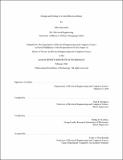| dc.contributor.advisor | Karl K. Berggren and Phillip D. Keathley. | en_US |
| dc.contributor.author | Simonaitis, John(John William) | en_US |
| dc.contributor.other | Massachusetts Institute of Technology. Department of Electrical Engineering and Computer Science. | en_US |
| dc.date.accessioned | 2021-05-24T20:23:55Z | |
| dc.date.available | 2021-05-24T20:23:55Z | |
| dc.date.issued | 2021 | en_US |
| dc.identifier.uri | https://hdl.handle.net/1721.1/130788 | |
| dc.description | Thesis: S.M., Massachusetts Institute of Technology, Department of Electrical Engineering and Computer Science, February, 2021 | en_US |
| dc.description | Cataloged from the official PDF version of thesis. "February 2021." | en_US |
| dc.description | Includes bibliographical references (pages 80-85). | en_US |
| dc.description.abstract | One of the primary limiting factors of modern electron microscopes is the damage imparted to samples during imaging, which limits the achievable image resolution for many biological specimens [1]. Recently, there have been several microscope designs proposed to improve resolution in these samples by reducing beam damage employing novel quantum measurement schemes such as interaction free measurement [2] and multi-pass electron microscopy [3]. These designs fall under the heading of a quantum electron microscope (QEM). A recurring element of all actively explored QEM designs is a linear cavity for recirculating electrons. This cavity, which could be inserted into existing microscopes, would allow for either the wavefunction transfer required for interaction free measurement or the phase build-up needed for multi-passing protocols to reduce specimen damage. | en_US |
| dc.description.abstract | In order to achieve these modes, there must be some way to open and close this cavity in a controlled fashion to allow electrons to enter, stably recirculate, then exit the setup. One approach to realizing such a cavity is the construction of a gated electron mirror, an electron optical element capable of switching between two operating states. In one state it transmits electrons travelling along its optical axis, while in the other it reflects them back onto their incident path. This gated mirror is required to operate at kilovolt potentials and reflect electrons with high accuracy within a several-nanosecond switching time frame. In this thesis, we aim to develop, build, and test such a gated electron mirror. We first outline in Chapter 1 the electron-damage problem, approaches to solving it, and how QEM might do this. Next, in Chapter 2, we review state-of the art fast pulsing approaches, as well as requirements for the mirror. | en_US |
| dc.description.abstract | In Chapter 3 we then design and test a fast pulse generating circuit based on emerging Gallium Nitride on silicon technology. In Chapter 4 we simulate the performance of the gated mirror. We optimize the structure of the gated mirror to minimize transition times and errors, and avoid induced voltage changes in other parts of the apparatus. We also discuss various design approaches to improve device performance, such as integrating high voltage pulsing electronics into the gated mirror itself. We also discuss the ultimate limits of switching. In Chapter 5 we then develop and show progress on an apparatus for testing the switching characteristics of the gated mirror in both time and frequency domains, directly probing the changing fields using an electron beam. Finally, in Chapter 6 we discuss improvements to our measurements and next steps. | en_US |
| dc.description.statementofresponsibility | by John Simonaitis. | en_US |
| dc.format.extent | 85 pages | en_US |
| dc.language.iso | eng | en_US |
| dc.publisher | Massachusetts Institute of Technology | en_US |
| dc.rights | MIT theses may be protected by copyright. Please reuse MIT thesis content according to the MIT Libraries Permissions Policy, which is available through the URL provided. | en_US |
| dc.rights.uri | http://dspace.mit.edu/handle/1721.1/7582 | en_US |
| dc.subject | Electrical Engineering and Computer Science. | en_US |
| dc.title | Design and testing of a gated electron mirror | en_US |
| dc.type | Thesis | en_US |
| dc.description.degree | S.M. | en_US |
| dc.contributor.department | Massachusetts Institute of Technology. Department of Electrical Engineering and Computer Science | en_US |
| dc.identifier.oclc | 1252064375 | en_US |
| dc.description.collection | S.M. Massachusetts Institute of Technology, Department of Electrical Engineering and Computer Science | en_US |
| dspace.imported | 2021-05-24T20:23:54Z | en_US |
| mit.thesis.degree | Master | en_US |
| mit.thesis.department | EECS | en_US |
